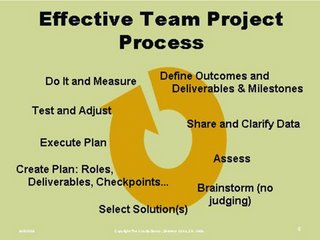This means lots of time spent in meetings, much of which is spent spinning wheels. During these meetings, people often bring other work, check their Blackberries, or think about what else they could be doing if they weren't in this meeting.
My experience is that most project teams, departmental or cross-functional, aren't very efficient or effective. So what makes a project team successful?
Last week I was at Harvard, delivering a half-day session for the Maynard Institute's Media Academy, a leadership development program for high-potential managers from diverse backgrounds. The group of 20 managers was divided into project teams at the beginning of the week-long program and given a business case study. The week ended with project team presentations, with each team giving their analysis and recommendations. My session was early in the week; the topic was team dynamics and process. The point was to help these project teams recognize what makes teams successful and what derails them, to set them up for success.
Below are some of the key points from the session I delivered.
- Research from Eckes and Associates shows that the root cause of most project team failures is poor team dynamics.
- The Loyalty Group's experience shows that the following are success factors for project teams:
- Common, clearly-defined goals.
- Trust and a “safe” environment.
- Everyone participates.
- Perceived importance of the project or goals.
- Team agreements/ground rules.
- All team roles are fulfilled (diverse styles, approaches, ways of thinking, etc.)
- An effective Team Process (see graphic below, copyright The Loyalty Group, Inc.).
- Most project teams move too quickly through the first step, defining outcomes, deliverables and milestones. They don't clearly define the end. As I told my Mayard group, one of my mantras is "Start with the End." If you're not clear on where you're going, why, and what success will look like...you're throwing darts at a moving target while blindfolded. It's inefficient and unproductive.
- Depending on the team dynamics and styles of team members, teams may get stuck in the assessment phase (over-analyzing) or jump to selecting solutions too quickly (driving to get the project done).
In our session, we used a Team Dimensions Profile, developed by Inscape Publishing. It worked really well and gave us a framework for talking about people's roles in teams. The Harvard session participants had very rich discussions after seeing their personal profiles and gained insights into why their project teams were working or stuck in storming (wheel spinning). My only advice if you're going to use this instrument is that you do it yourself first, then walk your participants through it step by step. The instructions are a bit confusing in the participant assessment booklet.
There is so much more out there on team dynamics and what makes project teams work. It's a very complex topic (read Animal Farm or Lord of the Flies). What can you do? The next time you're assigned to a project team, step up by: insisting on a clear process that "starts with the end", defining roles and ensuring diversity on the team, and facilitating healthy discussions about team dynamics along the way. Your time is too valuable to waste.
©2006 The Loyalty Group. All Rights Reserved. www.TheLoyaltyGroup.com






No comments:
Post a Comment